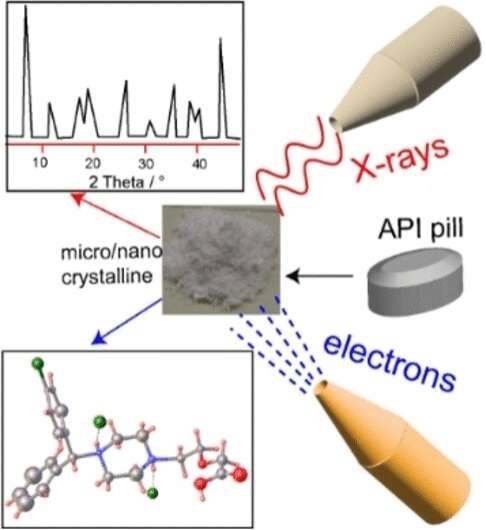This article has been reviewed according to Science X's editorial process and policies. Editors have highlighted the following attributes while ensuring the content's credibility:
fact-checked
peer-reviewed publication
trusted source
proofread
Determining the elusive structure of the antihistamine Levocetirizine

For pharmaceuticals, knowing the chemical composition is not enough—molecular geometry and crystal structure also play an important role in a drug's activity. By using a method based on electron diffraction, it has now been possible for a research team to determine the structure of Levocetirizine, as reported in the journal Angewandte Chemie. The advantage of this technique is that, unlike for X-ray crystallography, nanoscale crystals are sufficient.
Despite being chemically identical, many pharmaceutical substances may adopt different crystal structures or form cocrystals with an additive. This can significantly influence the properties of a drug, such as bioavailability, solubility, stability, and tabletability. Structural determinations are correspondingly important in the development of advanced solid pharmaceuticals.
Today, the standard and routine method for determining the three-dimensional structures of crystalline molecules and biological macromolecules with atomic resolution is single-crystal X-ray diffraction structure analysis (SCXRD). The atoms within the crystal diffract the X-ray radiation, forming a diffraction pattern from which the positions of the individual atoms in the structure of the crystal can be calculated. This requires sufficiently large, well-diffracting single crystals.
However, many compounds are difficult or impossible to crystallize. An alternative method is powder X-ray diffraction (PXRD), which can analyze a sample in the form of a powder. However, the data analysis is not straightforward and if the sample is a mixture of several phases of the same or different compounds, it is very difficult and often ambiguous.
A more recent technique is 3D-electron diffraction/micro-crystal diffraction (3D ED/MicroED). Instead of X-rays, electron beams from an electron microscope are diffracted. Because the interaction of matter with electrons is significantly stronger than interactions with X-rays, sub-micro to nanometer-sized crystals produce diffraction patterns that can be evaluated and direct analysis of components in microcrystalline mixtures becomes possible.
A team led by Durga Prasad Karothu and Panče Naumov has used 3D ED/MicroED to determine the structure of Levocetirizine dihydrochloride. Levocetirizine is an over-the-counter oral antihistamine used to treat allergy symptoms such as hay fever and hives. Although it has been in broad use, its crystal structure has remained unknown because no crystals good enough for X-ray crystallographic analysis could be grown. Recently, the structure of this medication was studied using powder X-ray diffraction and computer calculations—but uncertainty and ambiguity remained.
The team at New York University Abu Dhabi (United Arab Emirates), Rigaku Europe SE (Neu-Isenburg, Germany), and New York University (New York, U.S.) worked with crystals obtained by grinding commercially available tablets. In addition to determining the drug's crystal structure, they were able to use a special evaluation process (dynamical refinement) to unambiguously determine the absolute configuration (the exact spatial arrangement of all atoms within the molecule) of Levocetirizine.
More information: Durga Prasad Karothu et al, The Elusive Structure of Levocetirizine Dihydrochloride Determined by Electron Diffraction, Angewandte Chemie International Edition (2023). DOI: 10.1002/anie.202303761
Journal information: Angewandte Chemie International Edition , Angewandte Chemie
Provided by Wiley





















